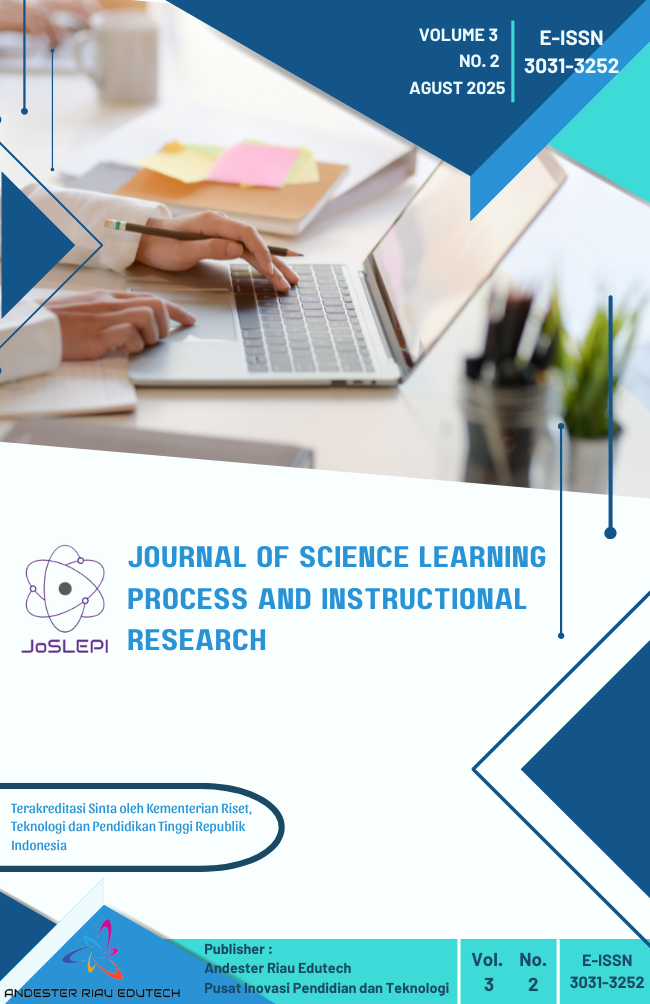Implementation of Case Based Learning Model on Vibration and Wave Materials on Student's Cognitivie Learning Outcomes of Grade VIII SMPN 7 Pekanbaru
Keywords:
Case Based Learning, Cognitive Learning Outcomes, Vibrations and WavesAbstract
This research further emphasizes the contribution of the Case Based Learning (CBL) model in improving students’ cognitive learning outcomes on vibration and wave materials in grade VIII of SMPN 7 Pekanbaru. The implementation of the CBL model was designed to provide students with real-life cases related to vibrations and waves, encouraging them to analyze, discuss, and solve problems collaboratively. Through this process, students were actively engaged in constructing their knowledge, which led to better conceptual understanding compared to conventional learning that tends to be more teacher-centered. The analysis of the results indicates that the experimental group that received treatment using the CBL model not only achieved a higher average score (73.13) compared to the control group (61.87) but also showed greater improvement in critical thinking and problem-solving abilities. This suggests that CBL creates meaningful learning experiences by linking abstract physical concepts with practical applications, which is essential for enhancing students’ long-term retention and comprehension. Furthermore, the significance test confirmed that the difference in learning outcomes between the experimental and control classes was statistically significant, validating the effectiveness of the CBL approach. These findings imply that CBL is not only an effective alternative learning model for improving cognitive outcomes but also a pedagogical strategy that supports the development of higher-order thinking skills (HOTS) among junior high school students. In conclusion, the implementation of the Case Based Learning model on vibration and wave materials has proven to positively influence students’ cognitive learning achievements. This model can serve as a recommendation for teachers to foster more student-centered learning environments and to integrate problem-solving strategies that relate scientific concepts to real-world contexts. The study highlights the potential of CBL to be widely applied in science education as a means to cultivate more effective, engaging, and impactful learning processes in the classroom.
Downloads
References
Alfirahmani, Irawan, D., & Nasir, M. (2025). Development of Android-Based Physics Learning Media to Improve Computer Thinking Skills for High School Students. Journal of Sience Learning Process Aand Instructional Research (JOSLEPI), 3, 1–10.
Arikunto. (2009). Psikologi Pendidikan. Bandung: Pt. Remaja Rodaskarya
Dwicky Putra Nugraha, D. M. (2022). Hubungan Kemampuan Literasi Sains Dengan Hasil Belajar Ipa Siswa Sekolah Dasar. Jurnal Elementary, 5(2), 153. https://doi.org/10.31764/elementary.v5i2.8874
Harahap, T. K., Indra, I. M., Issabella, C. M., Yusriani, Hasibuan, S., Hasan, M., Musyaffa, A. ., Surur, M., & Ariawan, S. (2021). Metodologi Penelitian Pendidikan. In Pustaka Ramadhan.
Ikhsan, K. Z. Z. P. R. (2025). Implementation of a Simulation-Based Learning Model Using PHET to Improve Learning Outcomes for Class IX MTsN 1 Kuantan Singingi. Journal of Educational Sciences, 5(4), 715–723.
Listiani, W. (2022). Transformasi Taksonomi Bloom dalam Evaluasi. 2(03), 397–402.
Mahardika, H. C., Ismawati, R., & Rahayu, R. (2022). Penerapan LKPD berbantuan simulasi PhET untuk meningkatkan motivasi dan hasil belajar kognitif IPA peserta didik SMP. Edu Sains: Jurnal Pendidikan Sains & Matematika, 10(1), 61–70. https://doi.org/10.23971/eds.v10i1.3170
Mahombar, A. (2024). Analisis Pemahaman Konsep dan Kendala Pemahaman Konsep Materi Getaran dan Gelombang. Jurnal Fisika Dan Pembelajaran (PHYDAGOGIC), 6(2). https://doi.org/10.31605/phy.v6i2.3683
Maknun, D. L., Irawan, D., & Azhar. (2025). Implementation of the Nearpod-Assisted CORE Learning Model to Improve Students ’ Understanding of Class VII SMP Negeri 20 Pekanbaru ’ s Concepts on Motion and Force Material. Journal of Science: Learning Process and Instructional Research (JoSLEPI), 3(1), 42–49.
OCDE. (2024). Pisa 2022. In Perfiles Educativos (Vol. 46, Issue 183). https://doi.org/10.22201/iisue.24486167e.2024.183.61714
Putu, N., & Dharmayanthi, I. (2022). Penerapan Model Case Based Learning ( CBL ) Mengembangkan Critical Thinking Skills Siswa Pembelajaran Geografi di SMA Negeri 1 Kuta Utara untuk dalam. 10(3).
Simbolon, D. H. (2022). Pengaruh Model Case Based Learning ( CBL ) Terhadap Hasil Belajar Mahasiswa. 1(03), 2020–2023.
Sugiyono. (2021). Metode Penelitian Pendidikan. Bandung: ALFABETA
Suparya, I. K., I Wayan Suastra, & Putu Arnyana, I. B. (2022). Rendahnya Literasi Sains: Faktor Penyebab Dan Alternatif Solusinya. Jurnal Ilmiah Pendidikan Citra Bakti, 9(1), 153–166. https://doi.org/10.38048/jipcb.v9i1.580
Downloads
Published
How to Cite
Issue
Section
License
Copyright (c) 2025 Wulan Sri Andayani, Muhammad Nasir, Muhammad Sahal

This work is licensed under a Creative Commons Attribution-ShareAlike 4.0 International License.













